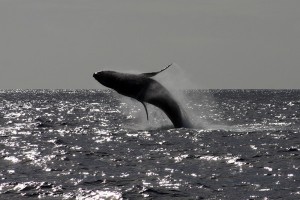
**IMPORTANT PARK NOTICES**
Monitor weather reports before your park visit.
•
[ALL ISLANDS] UPDATE – 12/12/25: Camping - Reservations for February 1, 2026 and beyond available at https://explore.ehawaii.gov, please create an account on Explore Outdoor Hawaiʻi to make a camping reservation.
Whales and Dolphins
Posted on Dec 8, 2014 Humpback whales (koholā) venture to Hawaiʻi each winter from Alaska, and are by far the most common whales seen in Hawaiian waters, although there have been sightings of fin, minke, Bryde’s, blue, and North Pacific right whales as well. Dolphins (nai‘a) are year-round residents. These magnificent animals can be viewd from shore by watching for their spouts as they surface to breathe. They also breach, leaping out of the water and creating great splashes which can be seen from a great distance at good viewing spots.
Humpback whales (koholā) venture to Hawaiʻi each winter from Alaska, and are by far the most common whales seen in Hawaiian waters, although there have been sightings of fin, minke, Bryde’s, blue, and North Pacific right whales as well. Dolphins (nai‘a) are year-round residents. These magnificent animals can be viewd from shore by watching for their spouts as they surface to breathe. They also breach, leaping out of the water and creating great splashes which can be seen from a great distance at good viewing spots.
Humpbacks can approach lengths of 50 feet and weigh up to 45 tons. They are known for their breaching and leaping behaviors, as well as fin and tail slapping, as well as singing. Males sing when in Hawaiian waters, but are silent when they return to Alaska, where they feed throughout the Spring and Summer. The whales mate in Hawaiʻi, and females birth their calves here the following year.
Spinner dolphins live in pods often made up of dozens of individuals for protection and coordinated hunting. Common in Hawaiʻi, they frequent calm protected bays during the day where they rest and care for their young. These areas are important to avoid predators and recover from long nights of hunting in the open ocean. They are spectacular leapers, and as their name aptly suggests, they spin rapidly during their aerial manuoevers. Spinners are relatively small dolphins, measuring about 6 feet (2 meters) in length as adults, and have a distinctive coloration – dark on top, gray in the midle, and light on the belly.
Whales and dolphins should not be approached. Dolphins enter shallow bays in Hawaiian waters to rest, to mate and to give birth. These behaviors often lead to conflicts with human visitors entering their waters. Swimmers and boaters should remain at least 50 yards (45 meters) away from dolphins so as not to affect their rest or social behaviors. Humpback whales similarly birth their calves in Hawaiʻi each winter. Federal law requires no one approach within 100 yards of a Humpback Whale in Hawaiʻi Waters. For more info, visit https://dlnr.hawaii.gov/dar/species/marine-mammals/
All marine mammals are protected by federal and state law. An overview of this protection is provided below. For more information, check out the following websites:
- NOAA’s Office of Protected Resources
- Hawaii Administrative Rules 13-124: Endangered and threatened wildlife


